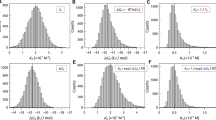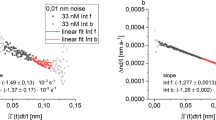ABSTRACT
Purpose
Analysis of simulated data was compared using sequential (NLR) and simultaneous non-linear regression (SNLR) to evaluate precision and accuracy of ligand binding parameter estimation.
Methods
Commonly encountered experimental error, specifically residual error of binding measurements (RE), experiment-to-experiment variability (BEV) and non-specific binding (BNS), were examined for impact of parameter estimation using both methods. Data from equilibrium, dissociation, association and non-specific binding experiments were fit simultaneously (SNLR) using NONMEM VI compared to the common practice of analyzing data from each experiment separately and assigning these as exact values (NLR) for estimation of the subsequent parameters.
Results
The greatest contributing factor to bias and variability in parameter estimation was RE of the measured concentrations of ligand bound; however, SNLR provided more accurate and less bias estimates. Subtraction of BNS from total ligand binding data provided poor estimation of specific ligand binding parameters using both NLR and SNLR. Additional methods examined demonstrated that the use of SNLR provided better estimation of specific binding parameters, whereas there was considerable bias using NLR. NLR cannot account for BEV, whereas SNLR can provide approximate estimates of BEV.
Conclusion
SNLR provided superior resolution of parameter estimation in both precision and accuracy compared to NLR.






Similar content being viewed by others
REFERENCES
Borgna JL. Requirements for reliable determination of binding affinity constants by saturation analysis approach. J Steroid Biochem Mol Biol. 2004;92:419–33.
Rovati GE, Shranger R, Nicosia S, Munson PJ. KINFIT II: a nonlinear least-squares program for analysis of kinetic binding data. Mol Pharmacol. 1996;50:86–95.
Rovati GE. Ligand-binding studies: old beliefs and new strategies. Trends Pharmacol Sci. 1998;19:365–9.
Burgisser E. Radiolagiand-receptor binding studies: what’s wrong with the Scatchard analysis. Trends Pharmacol Sci. 1984;5:142–4.
Horwitz EM, Jenkins WT, Hoosein NM, Gurd RS. Kinetic identification of a two-state glucagon receptor system in isolated hepatocytes. J Biol Chem. 1985;260(16):9307–15.
Oscar TP. Glucagon binding to receptors on the surface of chicken adipocytes. J Aim Sci. 1995;73:728–37.
Post SR, Miyazakij H, Tagern HS. Identification of a Mg2+- and guanyl nucleotide-dependent glucagon receptor cycle by use of permeabilized canine hepatocytes. J Biol Chem. 1992;267(36):25776–85.
Bharucha DB, Tager BS. Analysis of glucagon-receptor interactions on isolated canine hepatocytes: formation of reversibly and irreversibly cell-associated hormone. J Biol Chem. 1990;265(25):3070–9.
Karlsson MO, Neil A. Estimation of ligand binding parameters by simultaneous fitting of association and dissociation data: a Monte Carlo simulation study. Mol Pharmacol. 1988;35:59–66.
Beal SL, Sheiner LS. NONMEM users guide. San Francisco: NONMEM project group. University of California at San Francisco; 1994.
Karlsson MO, Sheiner LB. The importance of modeling interoccasion variability in population pharmacokinetic analyses. J Pharmacokinet Pharmacodyn. 1993;21(6):735–50.
Ette EI. Comparing non-hierarchical models: application to nonlinear mixed effects modeling. Comput Biol Med. 1996;26(6):505–12.
Boeckmann AJ, Sheiner LB, Beal SB. NONMEM users guide, vol. 1–5. San Francisco: NONMEM Project Group; 1994.
Baulieu EE. Hormones, a complex communications network. In: Baulieu EE, Kelly PA, editors. Hormones: from molecules to disease. New York: Hermann Publishers in Arts and Science, Chapman and Hall; 1990. p. 3–174.
Dandliker WB, Hsu ML, Levin NJ, Rao BR. Equilibrium and kinetic inhibition assays based upon fluorescence polarization. Methods Enzymol. 1981;74:3–28.
Karlsson MO, Neil A. Estimation of binding parameters by kinetic data analysis: differentiation between one and two binding sites. Eur J Pharmacol. 1988;148:115–21.
Author information
Authors and Affiliations
Corresponding author
Rights and permissions
About this article
Cite this article
Ernest, C.S., Hooker, A.C. & Karlsson, M.O. Methodological Comparison of In Vitro Binding Parameter Estimation: Sequential vs. Simultaneous Non-linear Regression. Pharm Res 27, 866–877 (2010). https://doi.org/10.1007/s11095-010-0082-1
Received:
Accepted:
Published:
Issue Date:
DOI: https://doi.org/10.1007/s11095-010-0082-1




